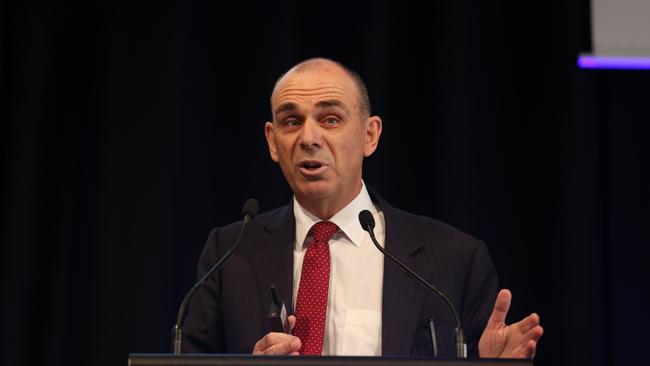APRA mulls future of bank dividend cap
APRA is considering easing its demands that banks cap dividends at 50 per cent of profit during the Covid crisis.

The banking regulator has hinted it may relax dividend guidance that caps payments at half of bank profits, due to increased capital in the sector and a more positive economic climate.
The Australian Prudential Regulation Authority’s chairman Wayne Byres stopped short of saying the 50 per cent dividend guidance would be scrapped, but said the outlook had improved and the cap would be reassessed.
“We have deliberately never put in place (dividend) guidance for a long period of time because we want to stay agile, we want to stay flexible, we want to be able to be conscious of the environment that’s evolving,” he added at an online conference on Wednesday.
“Our first set of guidance only lasted for three months … then we introduced the 50 per cent (of statutory profit) guidance and said that only applied to the end of the year, and in thinking about what we do next obviously we’ll be minded of how the situation has evolved since.
“On the whole, I think the outlook has improved, bank capital has certainly increased, the economic situation looks more positive … We don’t want to be complacent but I think it is time that we look at the issue again.”
APRA’s initial guidance on dividends came as COVID-19 started to hit the economy and advised banks and financial institutions to seriously consider deferring dividend decisions, to preserve capital.
That was changed in July to the 50 per cent of profit dividend guidance, as Australia started to emerge from the depths of COVID-19 infections.
This year has proven tough for retirees and self managed superannuation funds that rely on dividends and term deposits for income, given the APRA guidance and record low interest rates.
Mr Byres also talked about upcoming reforms to bank capital requirements, which will change the amount banks need to set aside against some loans but not result in the industry needing to raise capital.
“We believe the banking system is adequately capitalised,” he said.
“We will be adjusting risk weights in a range of areas to help make sure capital is better allocated according to risk. Housing loans, which dominate the industry’s balance sheet, will be a particular area of focus.”
APRA will release details in the next few weeks.
“Without delving into all the details, probably the most fundamental change flowing from the proposals is that bank capital adequacy ratios will change. Specifically, they will tend to be higher,” Mr Byres said.
“That is because the changes we are proposing will, in aggregate, reduce risk-weighted assets for the banking system. Given the amount of capital banks have will be unchanged, lower risk-weighted assets will produce higher capital ratios.
“However, that does not mean banks will be able to hold less capital overall.”
The moves by APRA will boost domestic banks’ capital adequacy standings relative to international peers, deliver on an objective to make banks “unquestionably strong” and help banks navigate times of crisis.
Mr Byres’ comments on dividends and capital helped underpin a strong rally in major and regional bank stocks on Wednesday.
On APRA’s backing away from imposing a 50 per cent cap on financial metrics in banker pay structures, Mr Byres noted the regulator had not set a “prescriptive limit” as that could create as many problems as it solved.
“Hard-coding a 50 per cent cap into the standard would effectively lock entities into a ‘scorecard’ methodology, would discourage consideration of other remuneration tools (for example gateways and modifiers), and could restrict the opportunity for boards to adopt more innovative approaches that may be more suitable for their particular business,” he said.
“That said, we have not resiled at all from the principle that a sole focus on financial metrics is unacceptable.”
Remuneration shortcomings were highlighted in APRA’s supervisory findings, as well as the Hayne royal commission, with senior executives rewarded despite failures in risk management and poor community outcomes.
APRA has replaced the 50 per cent proposed cap on financial measures for variable remuneration with a requirement that metrics such as governance, culture and conduct account for “material weight” in pay structures. That is combined with a risk and conduct modifier which can potentially reduce bonus remuneration to zero.
The original proposal of a 50 per cent split for financial and non financial pay metrics raised the ire of the industry. The regulator has also outlined shorter deferral periods for bonus pay than initially proposed.
Mr Byres said the new pay proposal would be reviewed after four years and would “not be set and forget”.
His speech also delved into APRA’s superannuation data transformation project, which aims to drive “better industry practices and improve member outcomes”. Mr Byres flagged the next instalment of APRA’s heatmaps report - which calls out underperforming and high fee funds - would be released soon.




To join the conversation, please log in. Don't have an account? Register
Join the conversation, you are commenting as Logout